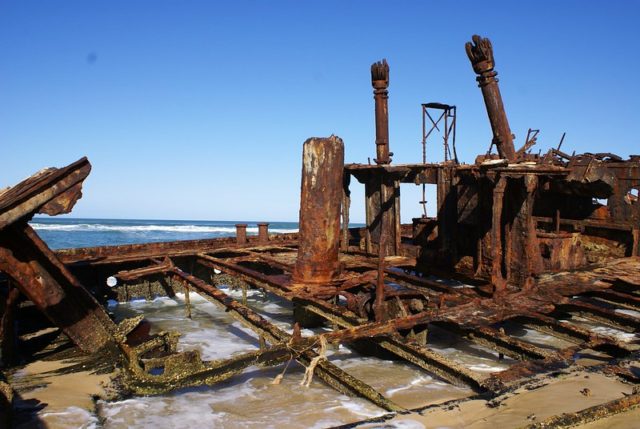Just off the coast of Fraser Island, Queensland, Australia sits the wreck of the SS Maheno. Initially built as a luxury ocean liner, the vessel was turned into a hospital ship during the First World War. After being sold to a Japan-based shipbreaker in 1935, it met tragedy when a cyclone hit it and its towboat.
The SS Maheno enters service as an ocean liner
The SS Maheno was commissioned by the Union Company of New Zealand and built by William Denny and Brothers, based out of Dumbarton, Scotland. The 5,000-ton steel-hulled ship was powered by three Parsons turbines, allowing it to travel at a speed of up to 17.5 knots. She was fully lit by electricity, a rarity during the early 1900s, and fitted with the latest safety equipment.


The Maheno, named after the township in Otago, was launched on June 19, 1905, and in November of that year went into service as a luxury ocean liner. She traveled along routes between Melbourne and Sydney, via ports in New Zealand and Tasmania, and even made regular voyages to Vancouver, Canada.


The ship could carry up to 420 passengers. A total of 240 were able to travel first class, while 120 were able to stay in second class accommodations and 60 in third class. Among the luxuries afforded to those rich enough to purchase first-class tickets included a dining room, a smoking room and a music room, which featured a Bechstein piano.
Turned into a hospital ship during World War I
At the onset of World War I, the SS Maheno was converted into a hospital ship, using money raised through an appeal by the Earl of Liverpool. Re-designated His Majesty’s New Zealand Hospital Ship (HMNZHS) No. 1, the dining and smoking areas were turned into eight wards and two operating rooms. In accordance with Article 5 of the 1899 Hague Convention, the ship’s exterior was repainted white, with a green stripe along the sides and red crosses on the funnels and sides.
The ship’s crew was outfitted with a medical team of five doctors, a matron, 13 nursing sisters from the New Zealand Army Nursing Service, 61 orderlies from the Army Medical Corps and chaplains.


HMNZHS No. 1 arrived at Moudros, Greece on August 25, 1915. It was one of the primary naval bases used during the Gallipoli Campaign, during which the Entente powers tried to weaken the Ottoman Empire by taking control of the Turkish straits. The ship then set off for ANZAC Cove, where it loaded casualties from the Battle of Hill 60, the last major assault of the campaign. It continued in this role for the next three months.


On January 1, 1916, the HMNZHS No. 1 arrived in New Zealand to be refitted, before leaving to collect more patients for transport. She then sailed to Southampton, arriving on July 3, 1916 – just two days after the start of the Battle of the Somme. Until October of that year, she continuously operated in the English Channel, transporting wounded soldiers from the Western Front.
In December 1916, the ship sailed back to New Zealand, after which she made six more trips between the country and the British Isles.


In November 1918, after three years of service in the war, the HMNZHS No. 1 was converted back to the SS Maheno and given permission to return to her duties as an ocean liner.
The SS Maheno‘s retirement and wreck
In 1935, the SS Maheno was retired and sold to a shipbreaker in Osaka, Japan. On July 3, she departed from Sydney under tow by the Oonah, a Tasmanian Steamers Pty. Ltd. Bass Strait ferry, attached to the vessel by a 900-foot, 6.75-inch wire rope.


On July 7, 1935, approximately 50 miles from the coast, the two vessels were hit by a cyclone, causing the tow line to snap. Attempts to reconnect the ships failed, and the Maheno and her crew of eight disappeared into the darkness. She was located three days later by aircraft, beached off the coast of Fraser Island. Her crew had set up camp onshore, and were rescued by the Oonah on July 12.
The Maheno was stripped of her fittings, after attempts to re-float the ship failed. There were also attempts to sell the vessel, but no potential buyers came forward.
A prohibited tourist destination
Since coming ashore on Fraser Island, the SS Maheno has remained, slowly corroding away under the area’s salt water conditions. The wreck has since been deemed a prohibited area by the Australian Department of Defence, due to unexploded ordnance contamination.


More from us: Built in the wrong place, this Australian lighthouse caused several shipwrecks
Despite the dangers, the ship is the location for annual ANZAC Day celebrations, with a replica of her bell located at the site. ANZAC day is a national day of remembrance in both New Zealand and Australia, dedicated to those who have served in conflict and war.
